Speedlight SB-700 is the Nikon's new mid-range flash gun that has replaced Nikon Speedlight SB-600 unit. SB-600, however, will be still available new and used for quite some time, so photographers are faced with the question whether to go for a newer model or save money and opt for the discontinued unit. The purpose of the article is to help answer this question by analyzing the differences between the two flashes.
If you just want to see the list of differences, check out the bullet point version of this article. For in-depth information about Nikon SB-600, please refer to Nikon Speedlight SB-600 flash review.
 |
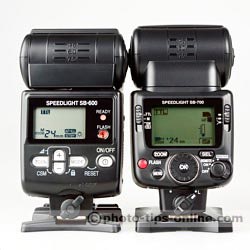 |
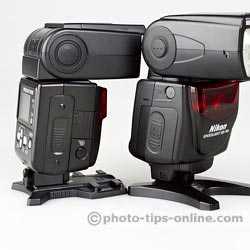 |
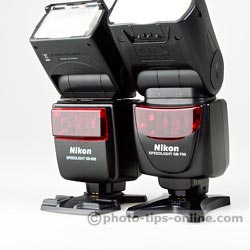 |
Nikon Speedlight SB-700 is a big leap forward compared to Nikon Speedlight SB-600. It feels like Nikon has made an attempt to reduce the gap between its flagship unit (SB-900) and the mid-range flash (SB-700) to make room for another model on the lower end of the line-up (between SB-400 and SB-700). Time will tell, but today we see that Speedlight SB-700 is better than its predecessor in almost every way.
The flash head of SB-700 is made after the high-end flash guns. The improvements from Nikon SB-600 include ability to tilt down 7 degrees, full 360 degrees rotation, extended zoom range, and built-in catchlight card.
| SB-700 | SB-600 | |
| Zoom range: | 14mm - 120mm | 14mm - 85mm |
| Catchlight card: | YES | NO |
| Tilt angles: | -7�, 0�, 45�, 60�, 75�, 90� | 0�, 45�, 60�, 75�, 90�. |
| Rotate angles: | 180� to the left and right | 180� to the left, 90� to the right |
Like its bigger brother, Nikon Speedlight SB-700 has the ability to change the illumination pattern. Nikon has dedicated a separate switch to make this function easily accessible. You can choose between standard, center-weighted, and even illumination patterns, which correspond to different types of light falloff at the frame edges. SB-600 lacks this feature completely, but you can compensate for it by switching to manual zoom mode. Setting your flash zoom to a wider than lens zoom position gives you more even lighting. Higher than lens zoom values make the light fall off more.
Unlike Nikon Speedlight SB-600 flash, the newer model can detect the sensor size (FX or DX) of the camera it is attached to. With DX type sensors, the flash adjusts flash zoom so that the area cropped by the sensor does not get illuminated, which prolongs the battery life.
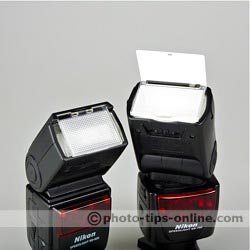 |
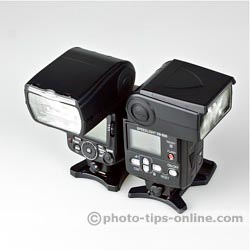 |
 |
Nikon Speedlight SB-700 features a bigger LCD screen, which is now a dot-matrix one and, therefore, is not limited to a set of symbols, but it can display arbitrary things (just like your computer screen, only monochrome). This change has allowed Nikon to better organize and present the on-flash menus. So, the new screen is a very nice move in terms of usability.
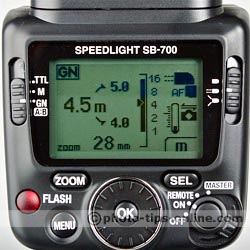 |
Nikon Speedlight SB-700 has significantly better controls. Besides the improved button layout, Nikon has added a selector dial (similar to SB-900) and a dedicated flash mode slider-switch.
The selector dial (wheel) is one of the greatest improvements in ergonomics and usability. It allows you quickly and intuitively adjusting almost every setting of your flash. (Manufacturers usually try to keep selector dials for the higher end flash guns and camera bodies to attract professional photographers.)
The new mode selector (slider) allows you to set a flash mode faster compared to cycling through modes by pushing a mode button.
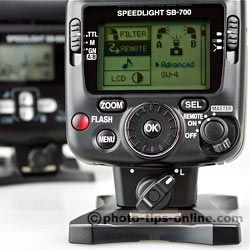 |
While the discontinued Speedlight SB-600 can only be a remote within Nikon's CLS system, Nikon SB-700 can also work as an optical slave (SU-4 mode) and as a master flash controller (although limited to only two groups, A and B). This is a huge advantage for everyone who's interested in off-camera flash photography, which should be everyone :).
On top of that, Nikon Speedlight SB-700 also features Quick Wireless Mode that is made for easy balancing lighting ratios of two remote flash groups (A and B).
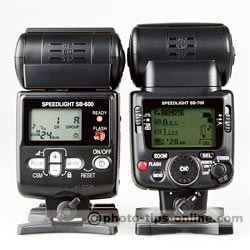 |
Nikon SB-700 can go down to 1/128th of the full power (SB-600's can only do 1/64th). This can be useful for close-up shots, where even the minimal flash output can sometimes be excessive.
Thermal cut-out is an important upgrade from SB-600. When you fire your flash in rapid successions, it is possible for the flash to overheat and break. Just like the big professional units, SB-700 has the built-in protection from overheating (it simply stops functioning until it sufficiently cools down). With Nikon SB-600, you have to take measures yourself and make sure not to fire too many times in a row.
Nikon Speedlight SB-700 firmware can be updated via some of the latest Nikon cameras. This feature makes the flash future-proof, as new fixes and features can be added to the flash in the convenience of your home. Nikon SB-600 has to be sent to a Nikon service center. Please note that the following cameras are not compatible with SB-700 firmware updates: D2 series, D1 series, D200, D100, D80, D70 series, D60, D50, and D40 series.
Besides i-TTL, i-TTL BL, and Manual shooting modes of SB-600, Nikon Speedlight SB-700 also has a Distance-priority mode (marked as GN on the mode slider). This mode allows you to have your subject perfectly illuminated at a certain distance that you must set manually. Basically, Distance-priority mode is the same old manual mode. The main difference is that you set the flash output not in fractions of the maximum, but in meters or feet, which can be useful. Please note that Distance-priority manual flash mode cannot be used when the flash head is tilted up or rotated to the right or left.
Nikon Speedlight SB-700 comes with a set of useful accessories, such as a diffusion dome and hard plastic color filters. The diffusion dome gives you more bouncing options and wider frame coverage. The color filters are great for color matching the temperature of the ambient light. The included two filters allow you matching the fluorescent and tungsten light. The filters are automatically recognized by the flash, and the camera's white balance is automatically adjusted. The automatic white balance adjustment only works with compatible cameras, which does not include D2 series, D1 series, D200, D100, D80, D70 series, D60, D50, or D40 series.
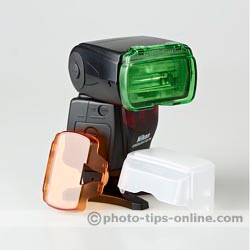 |
Even though Nikon Speedlight SB-700 is newer, it is slightly less powerful than its predecessor. Its Guide Number is 28m/92ft (at ISO 100, 35mm zoom), which is about 7% less than Guide Number of SB-600 (30m/98ft). In the real world applications, this kind of difference is not really noticeable, especially if you use your flash with light modifiers or bounce it off of walls and ceilings.
For any flash unit, weight is an important characteristic, especially if it is used on camera. In this respect, the older SB-600 has the edge since it's about 20% lighter than SB-700 (without batteries). It's not a huge difference, but it is quite noticeable when the flash is used with lower end camera bodies that typically are lighter.
It is also worth mentioning that the stand that is shipped with Speedlight SB-600 has a metal thread at the bottom, while the newer stand of SB-700 is all plastic. This is not a big issue, but if you intend to use the thread extensively, plastic is likely to wear out sooner.
Since Nikon Speedlight SB-700 is a more capable flash overall, it also has more custom functions. The following list summarizes what is new for SB-700:
Nikon Speedlight SB-600 has two custom functions that can be useful, but they were dropped with the release of the new model.
The first function allows you turning off the ready-light on the front on the flash. The second one lets you operate the flash even if you break off the built-in wide-angle diffusing panel. In case of SB-700, the flash has to be repaired and cannot be used.
Nikon Speedlight SB-600 has a rather unusual placement of batteries in the battery compartment, which requires a bit more attention to the polarity of the batteries, compared to the more typical 2x2 battery compartment found on SB-700. It's not a big issue, but might be worth mentioning.
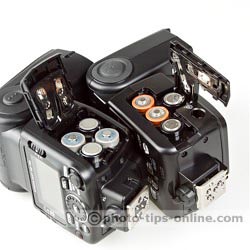 |
While both flashes support i-TTL and i-TTL BL modes, Nikon SB-700 does not allow manual switching between them. The mode is set automatically depending on the camera metering settings: i-TTL BL is used when camera's metering mode is set to matrix or centerweighted; standard i-TTL is activated when the camera is switched to spot metering. On one hand, this can be limiting in a way, and some users may prefer explicit TTL mode switching of Speedlight SB-600. On the other hand, automatic switching lets you take advantage of both modes without any effort.
SB-700 gets a different lightstand, which has only one mounting shoe, whereas the stand that comes with SB-600 has three shoes, two of which can be used with the SB-15 and SB-27.
Since Nikon Speedlight SB-700 comes with a bigger number of accessories, it also ships with a bigger carrying case. The shape of the new case is close to a square, but it's still very compact. It accommodates the flash itself, lightstand, diffusion dome, and color filters. There is also a small pocket inside the case for extra accessories.
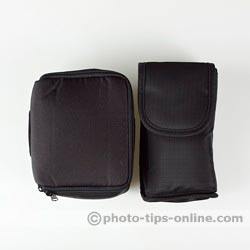 |
 |
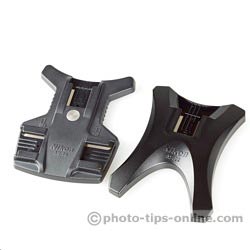 |
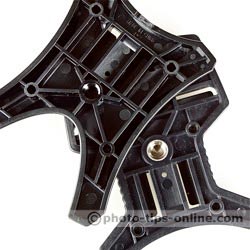 |
The new Nikon Speedlight SB-700 flash gun is, without a doubt, a better flash than Nikon Speedlight SB-600. It has a long list of improvements and new features not seen before on a flash of this class. With significant upgrades, like wireless master mode, better flash head, thermal protection, and improved ergonomics, SB-700 is the obvious choice in term of functionality. (The slightly reduced power and increased weight are not real deal-breakers.) Nikon Speedlight SB-600, however, can still attract customers with its lower price and time-tested reliability.